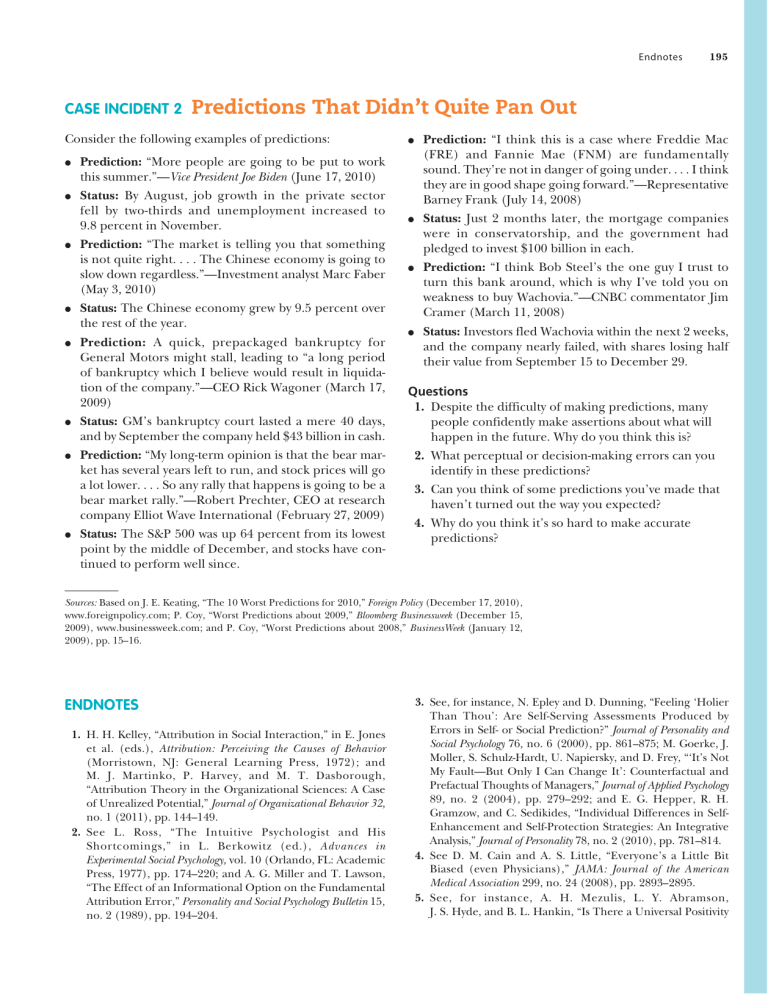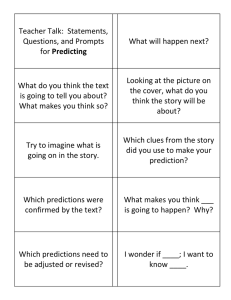
Endnotes CASE INCIDENT 2 Predictions That Didn’t Quite Pan Out Consider the following examples of predictions: ● ● ● ● ● ● ● ● 195 Prediction: “More people are going to be put to work this summer.”—Vice President Joe Biden (June 17, 2010) Status: By August, job growth in the private sector fell by two-thirds and unemployment increased to 9.8 percent in November. Prediction: “The market is telling you that something is not quite right. . . . The Chinese economy is going to slow down regardless.”—Investment analyst Marc Faber (May 3, 2010) Status: The Chinese economy grew by 9.5 percent over the rest of the year. Prediction: A quick, prepackaged bankruptcy for General Motors might stall, leading to “a long period of bankruptcy which I believe would result in liquidation of the company.”—CEO Rick Wagoner (March 17, 2009) Status: GM’s bankruptcy court lasted a mere 40 days, and by September the company held $43 billion in cash. Prediction: “My long-term opinion is that the bear market has several years left to run, and stock prices will go a lot lower. . . . So any rally that happens is going to be a bear market rally.”—Robert Prechter, CEO at research company Elliot Wave International (February 27, 2009) Status: The S&P 500 was up 64 percent from its lowest point by the middle of December, and stocks have continued to perform well since. ● ● ● ● Prediction: “I think this is a case where Freddie Mac (FRE) and Fannie Mae (FNM) are fundamentally sound. They’re not in danger of going under. . . . I think they are in good shape going forward.”—Representative Barney Frank (July 14, 2008) Status: Just 2 months later, the mortgage companies were in conservatorship, and the government had pledged to invest $100 billion in each. Prediction: “I think Bob Steel’s the one guy I trust to turn this bank around, which is why I’ve told you on weakness to buy Wachovia.”—CNBC commentator Jim Cramer (March 11, 2008) Status: Investors fled Wachovia within the next 2 weeks, and the company nearly failed, with shares losing half their value from September 15 to December 29. Questions 1. Despite the difficulty of making predictions, many people confidently make assertions about what will happen in the future. Why do you think this is? 2. What perceptual or decision-making errors can you identify in these predictions? 3. Can you think of some predictions you’ve made that haven’t turned out the way you expected? 4. Why do you think it’s so hard to make accurate predictions? Sources: Based on J. E. Keating, “The 10 Worst Predictions for 2010,” Foreign Policy (December 17, 2010), www.foreignpolicy.com; P. Coy, “Worst Predictions about 2009,” Bloomberg Businessweek (December 15, 2009), www.businessweek.com; and P. Coy, “Worst Predictions about 2008,” BusinessWeek (January 12, 2009), pp. 15–16. ENDNOTES 1. H. H. Kelley, “Attribution in Social Interaction,” in E. Jones et al. (eds.), Attribution: Perceiving the Causes of Behavior (Morristown, NJ: General Learning Press, 1972); and M. J. Martinko, P. Harvey, and M. T. Dasborough, “Attribution Theory in the Organizational Sciences: A Case of Unrealized Potential,” Journal of Organizational Behavior 32, no. 1 (2011), pp. 144–149. 2. See L. Ross, “The Intuitive Psychologist and His Shortcomings,” in L. Berkowitz (ed.), Advances in Experimental Social Psychology, vol. 10 (Orlando, FL: Academic Press, 1977), pp. 174–220; and A. G. Miller and T. Lawson, “The Effect of an Informational Option on the Fundamental Attribution Error,” Personality and Social Psychology Bulletin 15, no. 2 (1989), pp. 194–204. 3. See, for instance, N. Epley and D. Dunning, “Feeling ‘Holier Than Thou’: Are Self-Serving Assessments Produced by Errors in Self- or Social Prediction?” Journal of Personality and Social Psychology 76, no. 6 (2000), pp. 861–875; M. Goerke, J. Moller, S. Schulz-Hardt, U. Napiersky, and D. Frey, “‘It’s Not My Fault—But Only I Can Change It’: Counterfactual and Prefactual Thoughts of Managers,” Journal of Applied Psychology 89, no. 2 (2004), pp. 279–292; and E. G. Hepper, R. H. Gramzow, and C. Sedikides, “Individual Differences in SelfEnhancement and Self-Protection Strategies: An Integrative Analysis,” Journal of Personality 78, no. 2 (2010), pp. 781–814. 4. See D. M. Cain and A. S. Little, “Everyone’s a Little Bit Biased (even Physicians),” JAMA: Journal of the American Medical Association 299, no. 24 (2008), pp. 2893–2895. 5. See, for instance, A. H. Mezulis, L. Y. Abramson, J. S. Hyde, and B. L. Hankin, “Is There a Universal Positivity



